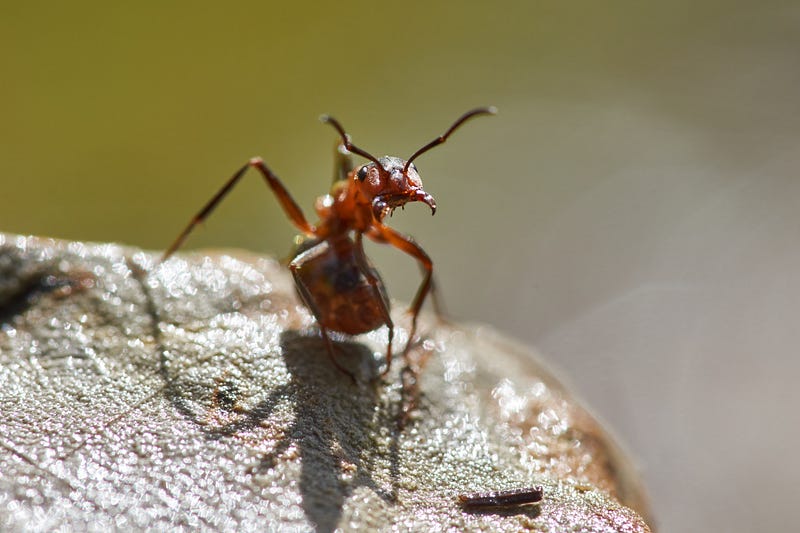How to Tackle Florida's Blood-Sucking No-See-Ums and Survive
Written on

It Seemed Like a Perfect Plan
“Let’s head to that charming spot by the docks for dinner,” our son suggested one evening during our visit to Florida. “It’s lovely down there, and we can savor the sunset.”
I appreciate a beautiful sunset, especially when shared with loved ones over a meal; it sounded like an ideal way to spend the evening. What could possibly go wrong?
Little did I know.
As the saying goes,
“The best laid plans of mice and men often go awry,”
a line from the Scottish poet Robert Burns.
Enjoying the Sunset
We stood on a wooden dock, resting against the railing as we gazed at the still waters, watching the sun transition from yellow to gold to orange as it descended in the sky. Soon, it hovered just above the horizon, enveloped in soft apricot clouds edged with lavender. The lavender deepened into purple, crowned with a fuchsia halo before the once-vibrant sun faded into murky violet and vanished.
The beauty of the sunset had momentarily transported me to another realm, making me forget my physical presence as I reveled in nature's splendor.
However, my tranquility was abruptly disrupted by an intense, burning itch all over my neck, ears, lower arms, ankles, and even the arches of my feet.
My frantic hands struggled to find relief, scratching everywhere.
That stunning coastal Florida sunset had turned into an all-you-can-eat buffet for the dreaded No-See-Ums, resulting in an almost maddening experience.

The Culprits
No-See-Ums are known by various names, including Biting Midges, Biting Gnats, or Punkies. Some mistakenly refer to them as “Sandflies” or “Sandfleas,” but that is incorrect. Technically, No-See-Ums belong to the “Ceratopogonidae” family, which comprises over 4,000 species. Florida alone is home to 47 different types of Biting Midges.
It's easy to see why they are called “No-See-Ums.” These minuscule gnats measure only 1–3 millimeters long—about the size of a pencil tip—allowing them to slip through window screens. Their tiny size makes them difficult to spot. They are most active during warm months at sunrise, sunset, and on calm, cloudy days.
No-See-Ums prefer to bite areas on the human body that are shielded from breezes, such as the back, shoulders, neck, calves, and behind the knees. These sheltered spots enable the pesky bloodsuckers to feast without being detected until it's too late.
Since No-See-Ums typically travel in groups, a single bite is unlikely; you may be bitten repeatedly by a nearly invisible swarm of female Biting Midges seeking protein from your blood to nourish their larvae.
Each creature serves a purpose, but after being bitten, it's hard not to view these tiny insects as pure nuisances.
Why No-See-Ums are More Torturous than Mosquitoes
Anyone who claims that ignoring the itch will make it vanish has likely never experienced an allergic reaction to insect bites and does not understand the relentless urge to scratch a deep, distinct itch.
The discomfort from No-See-Um bites can drive you to madness.
Here’s why No-See-Um bites are more bothersome than mosquito bites:
- Biting Midges possess saw-like teeth, which cause greater irritation compared to the needle-like proboscis of mosquitoes.
- The bites often result in clusters of bright red dots or large welts that may take hours or even days to become visible. In my experience, the itching and welts peak a day or two after the bite.
- A No-See-Um bite can create a welt up to two inches wide, while mosquito bites typically produce welts under half an inch.
- The sting from a Biting Midge can result in lesions that take weeks to heal, with persistent itching, unlike mosquito bites, which usually resolve within 3–4 days.
- Due to the extreme itch and the tendency to scratch, No-See-Um bites often become infected.
Why Some Individuals Itch More
Female No-See-Ums have both a needle-like sucker tube and an injector tube. When they bite, they inject saliva containing an anticoagulant that prevents blood from clotting, allowing them to feed more efficiently.
The more allergic your body is to this anticoagulant, the more you will itch. For those, like myself, who have severe reactions to insect bites, the itching can persist for days.
What to Do if You Get Bitten
Numerous remedies exist for treating No-See-Um bites, though none are guaranteed to work, but all are worth trying:
- Rinse the bites with cold water to remove any remnants of No-See-Um saliva.
- Apply rubbing alcohol to the affected areas.
- Use cold packs or frozen vegetables on the bites for ten minutes.
- Some individuals find relief by applying a hot cotton swab to the bite.
- Based on personal experience, victims suggest using Vicks Vaporub on the bite or spraying the itchy areas with Lemongrass Spray.
- Over-the-counter antihistamines and topical treatments like Benadryl can alleviate itching and inflammation.
Preventative Measures
While we can’t eradicate the insect population, we can take steps to protect ourselves from these irritating creatures.
Dress in long sleeves and pants when outdoors during peak biting times, such as sunrise or sunset. Outdoor enthusiasts might be aware of specialized, tightly woven fabrics that wick moisture and help regulate body temperature—often referred to as “wilderness wear.” This type of clothing can help keep No-See-Ums at bay.
If you plan to be near water, apply a repellent containing DEET, known to deter No-See-Ums. Some swear by Avon’s Skin-So-Soft, while others suggest natural deterrents like Pyrethrum, derived from Chrysanthemum flowers, or Rosemary. Citronella is also recognized as an effective repellent.
Keep in mind that peak biting times are early morning and evening, and apply repellents generously.
Surviving the No-See-Um Encounter
If you're allergic to the anticoagulant in Biting Midges, you know the excruciating itch can feel worse than being covered in poison ivy.
Eventually, the itch subsides, and the No-See-Um bites will fade, leaving behind darker pink spots that may linger like leopard spots for a month. But you will endure and have stories to tell, perhaps even laughing at those who advise you not to scratch.
Now, let me share my experience with a fire ant…

Melissa has been a target for bugs since birth, serving as a blood source for mosquitoes, No-See-Ums, and chiggers. She compares the overwhelming urge to scratch bug bites to her compulsion to write.
This content is not intended to serve as a substitute for professional advice, diagnosis, or treatment. Always consult your physician or qualified health provider with any questions regarding a health condition.